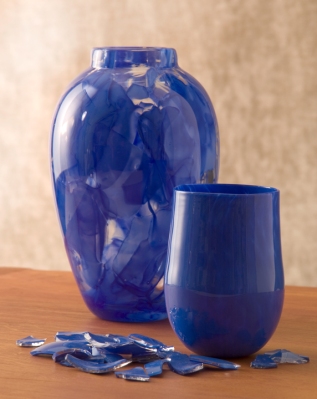 The shards of the broken glass are collected and "picked up" in perfectly compatible clear glass to create a vase.
The shards of the broken glass are collected and "picked up" in perfectly compatible clear glass to create a vase.
After the recitation of Sheva Brachot, or the Seven Blessings, the bride and groom drink from a cup of wine, place a glass on the floor in a cloth, and, with a triumphant stamp, the groom shatters it. The sound of broken glass signals the ceremony is complete as mothers and fathers, brothers and sisters, aunts and uncles, and the many friends cry out: “Mazel Tov!”
As the wedding moves into celebration mode, the broken glass is often discarded. But a small New York-based company called (appropriately enough) Mazel Tov Glass offers a unique spin on the age-old tradition. Instead of tossing the shards, couples can now place them in a convenient cloth bag, ship them back to the company, and have the broken glass incorporated into a hand-blown heirloom vase.
The business began in 2007 when Andrea Osnow and friend Susan Schulman, both experienced glassblowers, began making the vases for friends and family. Because they make the original cup used in the ceremony, they are able to incorporate the shards into a larger vase using compatible glass. Artist Kanik Chung is the main blower on the team, and Osnow’s daughter, Carly Levin, also steps in to help from time to time.
One can’t help but wonder whether re-making the broken glass might, in some way, take away from the ancient tradition of the broken glass. After all, the ritual is widely understood as a memorial to the destruction of the ancient Temple in Jerusalem. But there are other interpretations. Some say it reminds the groom of the fragility of love and marriage, as well as the break between single and married life. Others say, with tongue in cheek, that it’s the last time the groom gets to “put his foot down.”
Rabbi Avohom Marmorstein, member of the National Council of Synagogue Rabbis, an organization dedicated to the scholarly study of contemporary Jewish issues, holds to a more strict reading of Jewish custom. “I think the tradition is clear,” he says. “It was accepted by all Jews, 2000 years ago when the Temple of Jerusalem was destroyed, that they would commemorate the mourning and destruction at even the most joyous events. From a scholarly perspective, that is the correct explanation.”
Expert Anita Diamant, author of The New Jewish Wedding as well as forthcoming novel Day after Night, subscribes to a flexible interpretation. “The symbolism of the glass is multi-faceted, and it changes,” she says, affirming the customary Temple theory while making note of other modern interpretations. She points to the apparent sexual implications of the act; the breaking of the glass, she says, suggests the release of premarital sexual tension. She also explains how the ritual might have originated, with the notion that loud noises have the power to chase away evil spirits that are drawn, as spoilers, to beauty and happiness.
Rabbi Ahud Sela, a conservative rabbi from the Sinai Temple in Los Angeles, agrees. “That’s the nice things about Judaism,” he says. “You can take a tradition that might have been started for superstitious reasons and create a much more meaningful interpretation.”
Mazel Tov is not the only company looking to update the tradition. Websites such as Judaism.com offer specially embellished tubes and cases which can be filled with shards and displayed proudly. But Mazel Tov Glass seems to be the first to actually incorporate the shards into a new glass vessel, essentially restoring it to an unbroken state. Which brings up the question: If the glass is originally broken in commemoration of the destroyed holy Temple, what meaning could be found in its subsequent reconstruction? Might this practice give pause to even the most reform-minded of Jews?
Not so, says Osnow. “As long as the glass pieces are suspended in clear glass, preserving the shards rather than repairing them, it is not contradictory,” she says. “If we were to melt the pieces and make a new vessel, then that would be a problem.”
Diamant echoes the sentiment. “There is nothing sacred or all that special about the glass,” she says. “These are reminders of what was, hopefully, one of the most joyful days of your life. I think turning the glass into a vase or plate – something you might actually use – is a lovely touch.”
Rabbis, even the most conservative, seem to have few qualms about the Mazel Tov Glass innovation. Osnow is quick to point out that they have made several heirloom vases for rabbis. “People really like the concept of it,” she says. “It’s very sentimental. It’s a way of holding on to the memories.”
With the onset of the traditional “wedding season,” summer is the busiest season for Mazel Tov Glass. They intend to continue producing vases—even if they are, in a way, revising an ancient custom. And why not? As Rabbi Abraham Isaac Kook, the first chief rabbi of the state of Israel, once said, “The old becomes new – and the new becomes holy.”
—Brett Nuckles


